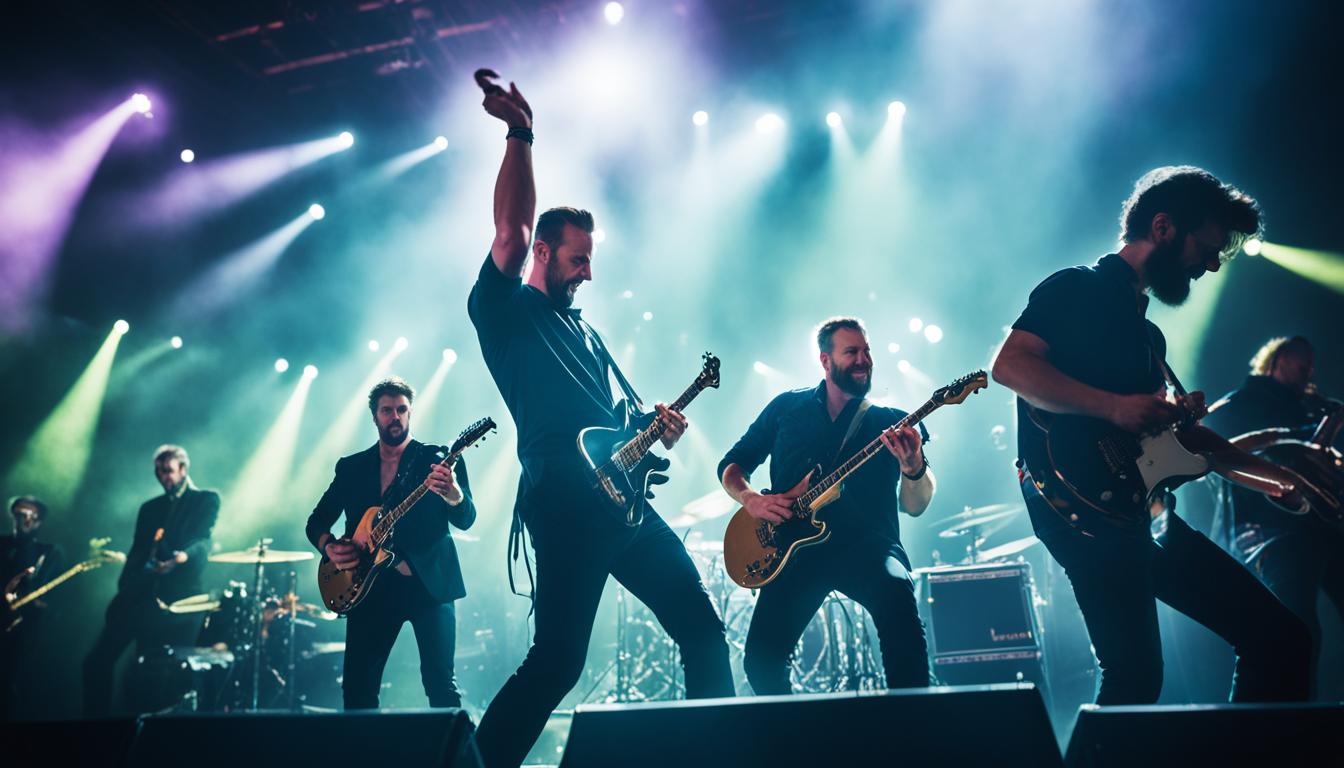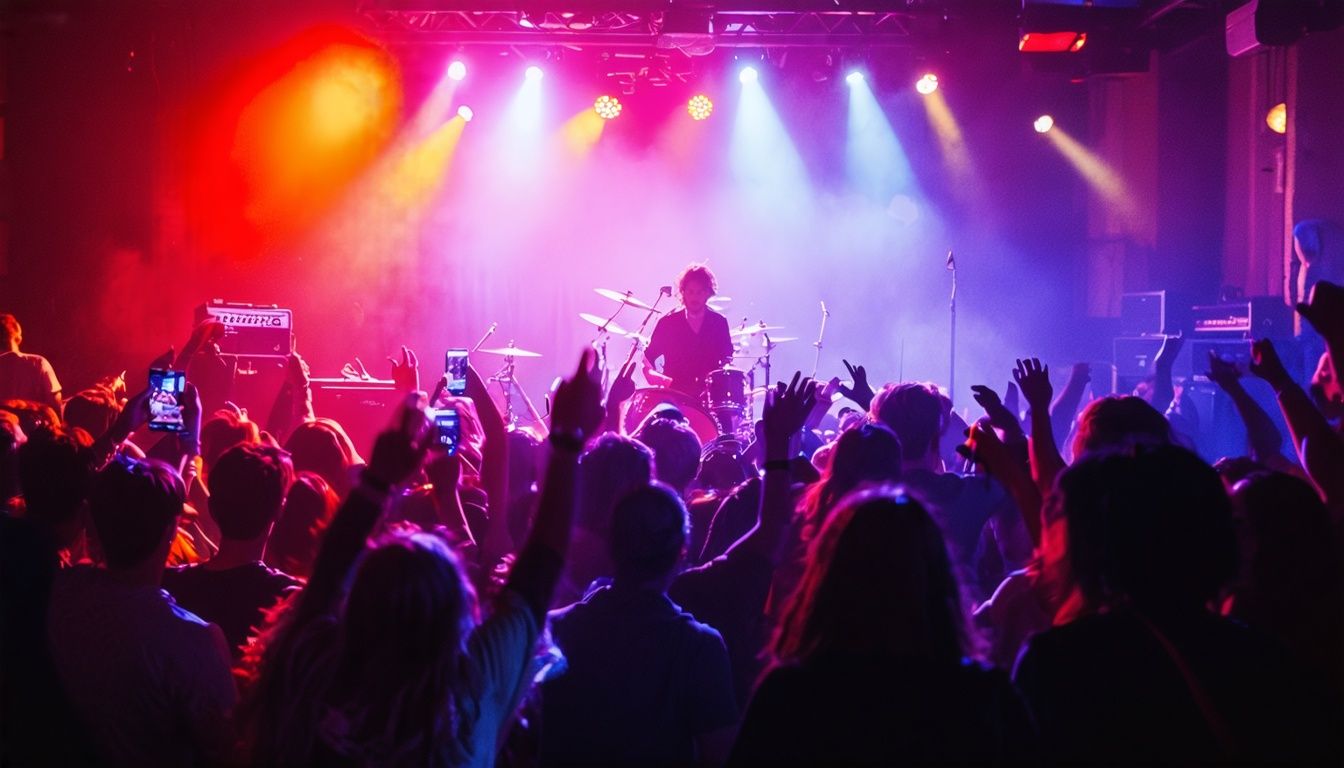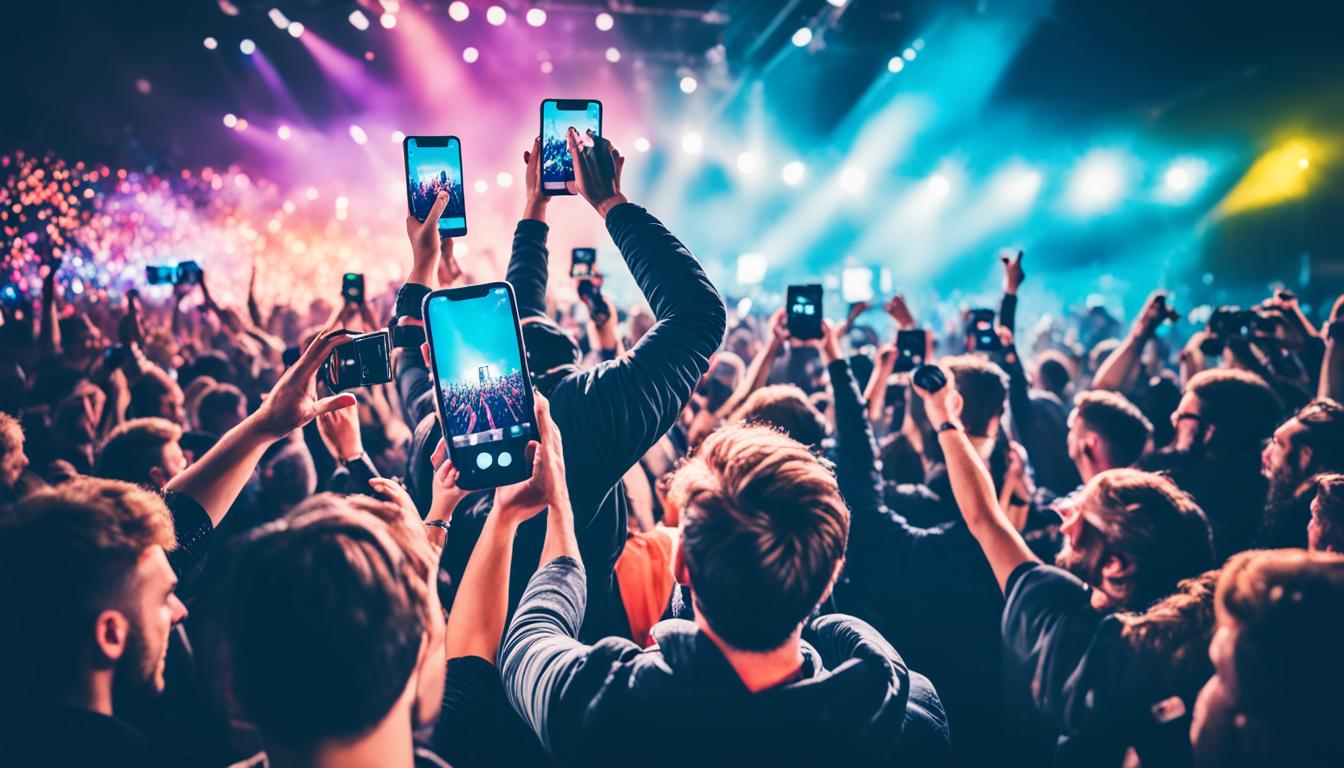The heart of live music photography beats in the moment’s energy. It’s about diving into the scene and capturing the vibrancy. With the right tips, we don’t just save a moment. We also catch the soul of the event, making each photo pulse with the room’s energy.
Our techniques go beyond just seeing. They enter the world of sound and how the audience reacts. Only specific methods can handle this live excitement. We mix our passion with skill to create a blend of visuals and sounds.
Key Takeaways
- Embrace the energy of the audience for authentic live music photography.
- Utilize dynamic concert photography tips to capture unforgettable music moments.
- Deploy specialized techniques geared towards the unique challenges of music event photography.
- Balance technical prowess with creative vision for capturing live music moments.
- Record the atmosphere and sound in harmony to fully capture the essence of a live music event.
Understanding the Essence of Live Music Energy
Live music events are special because of the melodies and the artist’s performance. But, the energy from the audience also plays a big part. This connection between the artist and fans is key in capturing live music moments. It makes the moments special for each person. We will look at how to best capture the feel of live music. We’ll also talk about the importance of music event photography in keeping these memories alive.
Role of the Audience in Live Recordings
The audience is at the center of any music event. They make live recordings feel real. When everyone reacts together to a song, it creates a bond. These moments are felt, not just heard. Capturing this feeling needs careful planning and the right mics. Using different microphones can catch the audience’s energy. This turns a simple recording into something you can almost feel.
The Impact of Venue Acoustics
The venue’s layout affects how live music sounds. Good or bad acoustics can change the feeling of a performance. Understanding a venue’s acoustics helps us make better recordings. Adjusting mics to fit the space can capture the event’s true sound. From the center to the ceiling, every mic position matters. It helps keep the live moment’s feel.
Integrating Crowd Reactions
Mixing crowd reactions with the performance is key. The audience’s cheers and singing add to the event’s feel. Making sure we hear the crowd as part of the music is important. It captures the real essence of a live show. The sound of people together tells the story of that moment. It’s not just what you see, but what you hear that matters.
Techniques for Capturing the Energy of Live Music
To master shooting concerts like a pro, we need to know some key things. It’s more than just owning a top-notch camera. It involves understanding how our gear works with the live music vibe. We’ll explore tips that help photo and audio pros get the essence of performances perfectly.
Strategies for Miking the Audience
Talking about how to photograph live performances means sharing tips from real experience. Our mics are like the ears of the recording, capturing the audience’s vibe. They grab the collective cheers and individual shouts, making listeners feel they’re in the crowd.
Positioning Mics for Optimal Sound Capture
We know the best camera settings for live music, but mic placement is crucial too. The goal is to find the venue’s sweet spots for the best sound. We avoid surfaces that bounce sound weirdly to catch the true feel of the performance.
Recording Techniques in Small Venues vs. Large Venues
Small venues offer a closeness we try to capture, making our miking simpler. However, large venues need a bigger setup to handle the space and sound movement. This approach lets us record the live music’s vibe well, making every performance feel intimate, no matter the size of the place.

| Venue Size | Miking Technique | Benefits |
|---|---|---|
| Small Indoor | Compact array, close to the audience | Intimacy, direct capture of audience reactions |
| Outdoor Festival | Heightened mic stands, spaced pairs | Broad coverage, ambient inclusion |
| Large Arena | Multiple directional mics, layered placement | Spatial sound, echo minimization |
Choosing the Right Equipment for Concert Photography
When we talk about concert photography, both skill and gear are key. It’s a blend of precision, patience, and the right camera settings for live music. This mix helps us capture those unforgettable moments.
Best Camera Settings for Live Music
Knowing how to use your camera’s manual mode is vital for shooting concerts. It’s key to use a fast shutter speed to stop motion, a wide aperture for more light, and the right ISO to keep photos clear in low light. Adjusting as the concert goes on keeps your photos sharp, even with fast-moving action and changing lights.
Camera settings for concerts might vary, so testing your setup during soundcheck can help you find the perfect settings.

Choosing the right lens is just as important as picking the camera. Go for lenses with a wide aperture, like f/2.8, to get the most light. Below, we cover essential gear for both new and pro concert photographers:
| Equipment Type | Why It’s Essential | Example |
|---|---|---|
| Camera with High ISO capability | Minimizes noise in low light conditions | Nikon D850 |
| Lens with Wide Aperture | Allows more light for clearer images | Canon EF 24-70mm f/2.8L |
| Fast Memory Card | Quickly saves large RAW files | Sandisk Extreme Pro |
With the right gear, you’re set to enter the world of concert photography. These tips and tools help you capture every moment. Embrace the challenge of adjusting settings as needed, and let your creative side shine. This way, you’ll catch the energy of live music perfectly.
Gearing Up for Low-Light Challenges
In the world of music event photography, we often face the challenge of dim venues. Capturing concerts means dealing with low light. It’s crucial to have the right camera settings and be ready for anything that happens on stage.
Adjusting Camera Settings in Dimly Lit Environments
We adjust our camera settings to get the perfect shot in the moment. Our gear’s high ISO is put to the test. It’s about finding a balance between ISO, aperture, and shutter speed. This balance helps avoid noisy images and capture the concert’s vibe.
Understanding when and how to adjust settings is key to professional concert photography. It’s not just about high ISO—it’s knowing how to use it right.
Handling High ISO and Noise Reduction
High ISO can be a challenge with high-megapixel cameras. But it doesn’t limit our final pictures. We use patience and creativity to overcome poor lighting and capture striking moments.
With noise reduction techniques, we keep the raw energy of live shows in our photos. Our goal is to tell the story of the event, one photo at a time.
FAQ
What are some techniques for capturing the energy of live music?
To capture live music energy, you need skill. This includes anticipating moments and being in the right spot. Adjusting your camera for low light and fast action is key. Feeling the music helps you capture its passion and movement.
What is essential for good live music photography?
Great live music photos come from understanding concert behavior and your gear. You need the right settings for the light, quick adjustments, and an eye for unique moments. These moments show the essence of the performance.
Any concert photography tips for beginners?
Beginners should know their equipment and practice in low light. Shoot local bands to build a portfolio. Look at other photographers’ work to learn different styles for capturing live music.
How does the audience contribute to live recordings?
The audience boosts the energy of live music with their reactions. Their cheers make the performance more lively and real.
What impact do venue acoustics have on concert photos?
The sound of a venue affects photos. Photographers must understand sound to position well. This lets them capture the venue’s acoustic energy visually.
Why is it important to integrate crowd reactions into live music photography?
Including crowd reactions shows the bond between artist and audience. It captures the live music experience’s shared energy and emotion.
What are some strategies for miking the audience?
Use omnidirectional mics for full crowd sound. Place mics around the venue for balanced audio. Mixing audience and ambient mics creates a live feel.
How do you position mics for optimal sound capture at live events?
Think about the venue’s sound, mic types, and recording goals. Place mics in front for direct sound or overhead for a direct and ambient mix. Mics by the sound console catch mixed audio during the show.
What recording techniques differ between small and large venues?
Small venues need simple miking for intimacy and short echo times. Mics catch direct audience sound easily. Large venues might need complex setups. This captures the audience’s full response and clear music.
What are the best camera settings for live music photography?
Ideal settings include high ISO, wide aperture, and fast shutter speed. Each event may need adjustments, so know how to change these manually.
What gear is essential for capturing melodic moments during concerts?
You need a high ISO camera, fast wide-aperture lenses, and a monopod. Don’t forget extra batteries and memory cards to shoot without stopping.
How do you adjust camera settings for dimly lit concert environments?
Adjust settings to maximize light without too much noise. Open aperture wide, manage shutter speed, and increase ISO carefully. Aim for the light without blurring motion.
How do you handle high ISO and noise reduction when photographing concerts?
Balance exposure and noise by choosing the lowest ISO for a good shot. Use noise reduction software wisely afterwards to keep quality high without losing details.



